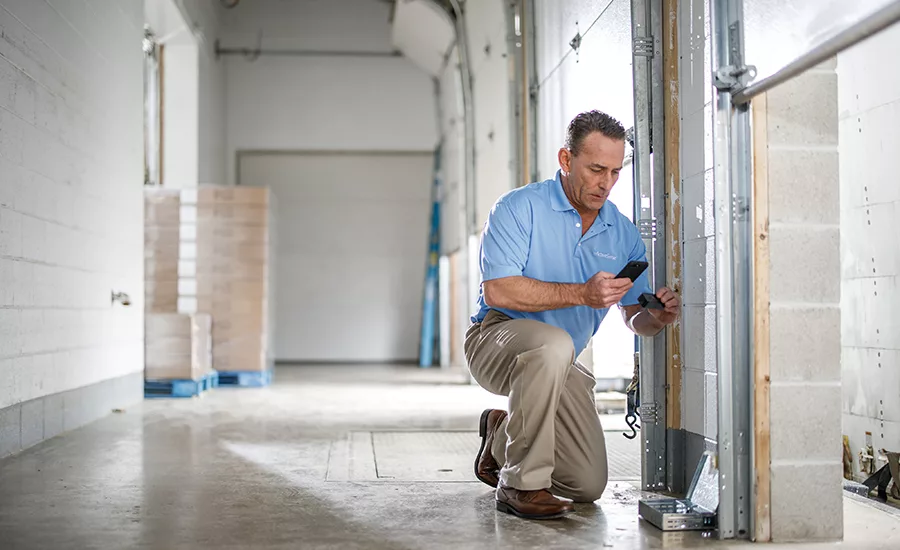Food safety and pest management
Working with a pest management provider can help keep infestations out of your food processing plant.

In-house pest management teams or a contracted PMP can use technology to monitor for pests and receive real-time alerts for pest activity. Photo courtesy of Corteva Agriscience
Food processing facilities offer the perfect conditions for pest intrusion. Rodents, flies, cockroaches and stored product intruders, such as beetles and Indian meal moths all can be the primary culprits behind the adulteration of the food supply.
Dr. Brittany Campbell, entomologist for the National Pest Management Association (NPMA), a non-profit organization that supports the pest management industry’s commitment to the protection of public health, food and property from the diseases and dangers of pests, says that proper pest control in food processing facilities has become even more important with the implementation of FSMA, as it gives the FDA much more authority and oversight. “As a result, a lack of or inadequate pest control programs can result in fines and shutdowns. In addition, facilities may be audited by a third-party to ensure they are meeting safety standards that have specific requirements in their code regarding pest control.”
The Food Safety and Modernization Act (FSMA) has six compliance requirements on an integrated pest management program for food and beverage processors:
- Create a written, preventative plan.
- Go beyond checking traps.
- Make corrective actions a priority.
- Maintain clear, consistent, and accessible documentation.
- Train your staff.
- Evaluate provider performance.

Strategies
A pest control company selects a pest management strategy based on an assessment of the pest problem. The strategy chosen can be influenced by many factors—including the location of the pest infestation, the severity of the infestation, the pest in question, the source of the infestation and any special requirements such as equipment or food.
After the initial assessment, a combination of approaches through an integrated pest management strategy could include exclusion, sanitation and the use of products for effective management.
Patricia Hottel, technical manager at McCloud Services, says it is important to offer a wide variety of service options to fit the needs of the site. “The development of the program begins with a site survey and assessment. The control plan is based on the results of this inspection, and once the program is developed, monitoring is required to verify that it is effective. Assessments of the program are ongoing and modifications to the program are made based on any needs identified in the program assessments,” she explains.
In addition to pest management providers (PMPs), many facilities use in-house managed programs and hybrid-type programs where some services are provided in-house and others by an outside contractor.
Different types of pests will require different pest management strategies. There are also a multitude of factors regarding the facility that will impact both the type of pests in the plant and the control methods selected. Hottel offers an example: The differences between a facility that is certified organic versus non-certified. There will be a mandated hierarchy of control steps utilized in combating a pest problem in a certified organic plant, with the first step being non-chemical. Meat processing plants will also have certain restrictions that differ from other sites. Lastly, the exterior environment, type of product produced, and the type of structure and sanitation level will all impact both the type of pest pressures experienced, and control efforts levied.

Make your plant a safe haven for food
To help keep pests out of your food processing facility, Dr. Brittany Campbell, entomologist for the National Pest Management Association (NPMA) recommends these steps:
Interior
- Ensure employee kitchens and break rooms are clean by wiping down counter tops and sweeping floors to remove crumbs and residue from spills.
- Vacuum and clean all areas regularly, including offices, hallways, lobbies and public bathrooms.
- Routinely check under sinks and machinery for areas of moisture and repair any leaky pipes or clogged drains.
- Store all food products in sealed containers and organize empty boxes to prevent harborage areas.
- Schedule regular inspections with a qualified pest control company that is experienced in working with food processing facilities to help identify vulnerabilities, survey for, and control issues using an IPM approach.
Exterior
- Keep trash in sealed containers inside the building and remove from the facility regularly. Ensure dumpsters are far away from any building entry points.
- Inspect the exterior of the building to ensure there are no entry points, paying close attention to areas where pipes and utilities enter the building, and seal any gaps or cracks in the foundation.
- Install door sweeps on exterior doors to seal the gap between the floor and the door where pests can enter.
- Remove debris from gutters and direct water away from the building through properly functioning downspouts, gutters and splash blocks.
- Install a gravel perimeter around the building to help discourage vegetation growth that could harbor pests.
- Ensure the grounds surrounding the facility are properly maintained, as overgrown vegetation can attract pests to the property.
Kevin Keim, ActiveSense strategic account manager at Corteva AgriScience, explains that the ActiveSense system enables in-house pest management teams or a contracted PMP to remotely monitor for pests and receive real-time alerts for pest activity. “The alerts include a timestamp and pinpointed equipment location, so your PMP knows exactly where and when activity is happening, allowing for a quicker response, swift root-cause analysis, prompt corrective action and faster issue resolution.”
Additionally, activity data gathered by the system can be analyzed by your PMP to identify trends and active hotspots, as well as inform proactive program adjustments that leave the facility better protected from pests in the long-term.
Integrated pest management
Integrated Pest Management (IPM) has become the standard practice of pest control, as it is a way of conducting pest control. Essentially, it is a program that encompasses identification of a pest, education, communication and utilizing a combination of approaches for successful management, Campbell explains.
IPM focuses on three basic techniques: inspecting for pests, identifying pests and treatment by pest control professionals. A complete approach, IPM bases its recommendations on each individual business’s unique needs.
Hottel says that IPM uses a variety of both non-chemical and chemical tools in managing pests. “All pest management programs will begin with an inspection and assessment. Afterwards, the program is developed to address the needs of the site. IPM simply means that a variety of tools will be incorporated in addressing those needs.”

As an added level of protection, an electronic remote monitoring system, like the ActiveSense system, is helpful because it allows the PMP to monitor for pest activity off-site as well. “When a pest issue arises, root-cause analysis and proper pest identification help inform the initial control opportunities, such as removing the food or water source, repairing entry points or increased sanitation. Pesticides are used as a last resort when ongoing monitoring and inspections deem its use necessary,” says Keim.
Partnerships
One of the most important steps in implementing an IPM program is choosing a reliable partner. When choosing your partner, Campbell advises to meet with several companies to find the best fit for your facility, ask detailed questions about their pest control practices and other clients they serve, inquire with industry peers and partners on their pest control experiences as well as check companies for membership of national, state or local associations as these memberships speak to a commitment to protecting public health and property from pests, and a desire to receive ongoing education about new technologies and treatment techniques.
Both Hottel and Keim agree on strong partnerships. “Some IPM strategies will include tasks that cannot be performed by the pest management company, such as increased sanitation efforts, a change in employee practices or structural modifications. The implementation of an IPM program takes coordination, communication and action by both parties,” says Hottel.

Keim adds that an experienced PMP can assist you throughout the process. “In addition to performing an initial risk assessment of your facility, the expertise of the PMP can ensure that the creation of a comprehensive program targets your facility’s unique pest pressures and adheres to FSMA requirements.”
Another important step? When hiring a PMP, it’s important to understand any technologies they use for food facilities, because it’s possible to get two drastically different programs based on their technology integrations.
Regulations
Many companies choose to work with a pest management professional to ensure they meet federal and state requirements and also pass audits. Of course, the FDA and USDA have roles to play in pest management at food and beverage facilities. Campbell explains that, depending on what food is processed in a facility, inspectors may document and expect corrective actions with a pest management issue. The inspector should present any violations and explain next steps for addressing any issues.
The FDA offers FSMA training and technical assistance on their website, as well as compliance and implementation tools, for anyone seeking regulation requirements.
Barriers
The abundance of food and shelter found inside food processing facilities make them ideal for pests. However, there is a zero-tolerance policy when it comes to the presence of pests in these facilities. A singular pest can quickly grow into full-blown infestation, making it extremely important for facility managers to ensure they have a year-round partnership with a reliable pest control company.
“Because many of the pests we encounter come from the exterior environment, pest proofing is a necessary component in preventing any pest issue,” explains Hottel. “These barriers will include door seals, dock plate leveler seals, screens and use of sealants. Reducing attractive conditions around the facility is another important barrier to pest activity.”
Keim adds that pest barriers and exterior bait stations can play an important role in protecting your facility because they serve as the first line of defense.
Sanitation
An obvious point but one that needs stating: something simple such as leaving leftover food laying around is a playground for pests. “Sanitation is a key element in pest prevention for food processing facilities. Food left on machinery or overflowing trash receptacles are a beacon for pests,” says Campbell.
Hottel adds that certain types of sanitation methods can actually contribute to pest activity if used improperly, such as compressed air and water under pressure in cleaning. “The use of compressed air should be avoided in facilities as a method of moving product residues. The lack of controlled compressed air use can move both food product and insects to areas where they may be more difficult to access. Similarly, water under pressure can also move food particles and moisture to areas where it may be difficult to remove food or dry up the moisture.”
Corteva AgriScience’s Keim agrees. “Product build-up can provide an attractant and food source for pests. Additionally, pests carry diseases and bacteria that can spread to the surfaces they encounter, threatening product safety. Proper and regular sanitation can help support food safety measures and ongoing pest prevention.
Looking for a reprint of this article?
From high-res PDFs to custom plaques, order your copy today!








